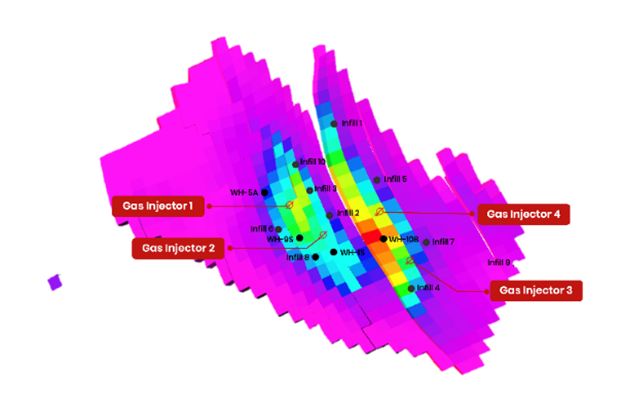Field Development with Scenario Reactivation of Non-Active Zones Through Reservoir Simulation: A Case Study of The Kappa Offshore Field, West Natuna
Keywords:
Declined Curve Analysis, Driving Mechanism Reservoir, Field Development, Gas Injection, History Matching, Infill Wells, Reservoir Simulation, Water InjectionAbstract
This research provides the scenario of a field development plant with the primary goal of acknowledging the reservoir model of Kappa Field in determining the optimum field development scenario to increase the recovery factor. In this research, field development will be carried out by creating scenarios that differentiate certain parameters to see the differences from these scenarios. The main problem in this field is to find out the feasibility of a field that has a history of production from 1986 to 2022 or for 33 years. In addition, the main objective of this research is to determine the reservoir driving mechanism of the Pasir RH-7 layer and determine the best field development scenario to optimize production in the Kappa field. The method used in this study is the reservoir modeling method using production data and reservoir data that has been obtained from the company and then managed using the Petrel Software assisted by Eclipse and MatBal. Before developing field development scenarios, an analysis is carried out using several different methods, including analysis with the decline curve analysis method in determining the remaining recoverable reserves as the validation of Kappa Field's feasibility, identify the driving mechanism of the reservoir, and history matching between history production data with simulation results. Sensitivity analysis of the field development is also conducted through various scenarios, including adding or adjusting well perforation interval, infill well adding, five water injection wells, and four gas injection wells. Other than that, injection gas and water rates in injection wells are also being exercised during the sensitivity analysis. Simulation results show the best scenario of Kappa Field is ten infill wells and four injection wells with a water injection rate of 1000 BWPD and gas injection rate of 1 MMSCF/d, giving the optimum recovery factor result of 39.33% from oil reserves. The results of this research will have a positive impact on the development of the Kappa field in order to increase production from fields that have been producing since 1986 and stopped production in 2019.
Downloads
References
Afifa, L. [WWW Document]. 2021. Sri Mulyani Calls Oil Production Decline a 'Challenging Situation'. URL https://en.tempo.co/read/1534269/sri-mulyani-calls-oil-production-decline-a-challenging-situation (Accessed 2022, November 30)
Ahmed, T.H. 2001. Reservoir Engineering Handbook. USA: Gulf Professional Publishing.
Alvarado, V. and Manrique, E. 2010. Enhanced Oil Recovery. Oxford: Gulf Professional Publishing.
Collins, A.G 1977. Enhanced Oil Recovery Injection Waters. Oil Field Subsurface Injection of Water. American Society for Testing and Materials, 641, 2-23.
Dake, L.P. 1978. Fundamentals of Reservoir Engineering. Elsevier: The Netherlands.
Meirita, M.F. 2003. Structural and Depositional Evolution, KH Field, West Natuna Basin, Offshore
Indonesia. Texas: Texas A&M University.
Palsson, B., Davies, D.R., Todd, A.C. Somerville, J.M. 2003. A Holistic Review of the Water Injection Process. SPE European Formation Damage Conference, The Hague PaperSPE #82224
Pratama, D. [WWW Document]. 2022, Juli 12. SKK Migas dan KKKS Sepakati 5 Rekomendasi Untuk Peningkatan Kinerja Hulu Migas. URL https://www.skkmigas.go.id/berita/skk-migas-dan-kkks-sepakati-5-rekomendasi-untuk-peningkatan-kinerja-hulu-migas (Accessed 2022, November 30)
Schlumberger [WWW Document]. 2022. Schlumburger Oilfield Glossary. URL https://glossary.oilfield.slb.com/en/terms/h/history_matching (Accessed 2022, November 30)
Smith, C.R. 1966. Mechanics of secondary oil recovery. USA: Reinhold Publishing Corp.
Willhite, G.P. 1986. Waterflooding. USA: SPE Textbook Series

Downloads
Published
Issue
Section
License
Copyright @2019. This is an open-access article distributed under the terms of the Creative Commons Attribution-ShareAlike 4.0 International License which permits unrestricted use, distribution, and reproduction in any medium. Copyrights of all materials published in JGEET are freely available without charge to users or / institution. Users are allowed to read, download, copy, distribute, search, or link to full-text articles in this journal without asking by giving appropriate credit, provide a link to the license, and indicate if changes were made. All of the remix, transform, or build upon the material must distribute the contributions under the same license as the original.










